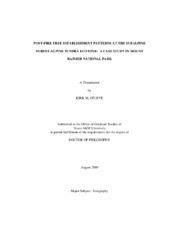| dc.contributor.advisor | Millington, Andrew C. | |
| dc.creator | Stueve, Kirk M. | |
| dc.date.accessioned | 2010-10-12T22:31:32Z | |
| dc.date.accessioned | 2010-10-14T16:02:38Z | |
| dc.date.available | 2010-10-12T22:31:32Z | |
| dc.date.available | 2010-10-14T16:02:38Z | |
| dc.date.created | 2009-08 | |
| dc.date.issued | 2010-10-12 | |
| dc.date.submitted | August 2009 | |
| dc.identifier.uri | https://hdl.handle.net/1969.1/ETD-TAMU-2009-08-7099 | |
| dc.description.abstract | Climatic changes have induced striking altitudinal and latitudinal vegetation
shifts throughout history. These shifts will almost certainly recur in the future;
threatening other flora and fauna, and influencing climate feedback loops. Changes in
the spatial distribution of vegetation are most conspicuous at physiognomically distinct
ecotones, particularly between the subalpine forest and alpine tundra. Traditionally,
ecological research has linked abiotic variables with the position of this ecotone (e.g.,
cold temperatures inhibit tree survival at high elevations). Thus, the prevailing
assumption states that this ecotone is in equilibrium or quasi-equilibrium with the
surrounding physical environment and that any dynamic shifts express direct linkages
with the physical environment.
This dissertation employs a landscape ecology approach to examine the abiotic
and biotic ecological mechanisms most important in controlling tree establishment at this
ecotone. The study site is on the western slopes of Mount Rainier, which was severely
burned by a slash fire in 1930. Therefore, a crucial underlying assumption is that the ecological mechanisms controlling tree establishment are similar at disturbed and
undisturbed sites. I exploited the use of 1970 CORONA satellite imagery and 2003
aerial photography to map 33 years of changes in arboreal vegetation. I created detailed
maps of abiotic variables from a LIDAR-based DEM and biotic variables from classified
remotely sensed data. I linked tree establishment patterns with abiotic and biotic
variables in a GIS, and analyzed the correlations with standard logistic regression and
logistic regression in the hierarchical partitioning framework at multiple spatial
resolutions.
A biotic factor (proximity to previously existing trees) was found to exert a
strong influence on tree establishment patterns; equaling and in most cases exceeding the
significance of the abiotic factors. The abiotic setting was more important at restricted
spatial extents near the extreme upper limits of the ecotone and when analyzing coarse
resolution data, but even in these cases proximity to existing trees remained significant.
The strong overall influence of proximity to existing trees on patterns of tree
establishment is unequivocal. If the underlying assumption of this dissertation is true, it
challenges the long-held ecological assumption that vegetation in mountainous terrain is
in equilibrium with and most strongly influenced by the surrounding physical
environment. | en |
| dc.format.mimetype | application/pdf | |
| dc.language.iso | en_US | |
| dc.subject | alpine treeline | en |
| dc.subject | tree establishment | en |
| dc.subject | hierarchical partitioning | en |
| dc.subject | hierarchical patch dynamics | en |
| dc.title | Post-fire Tree Establishment Patterns at the Subalpine Forest-Alpine Tundra Ecotone: A Case Study in Mount Rainier National Park | en |
| dc.type | Book | en |
| dc.type | Thesis | en |
| thesis.degree.department | Geography | en |
| thesis.degree.discipline | Geography | en |
| thesis.degree.grantor | Texas A&M University | en |
| thesis.degree.name | Doctor of Philosophy | en |
| thesis.degree.level | Doctoral | en |
| dc.contributor.committeeMember | Klein, Andrew G. | |
| dc.contributor.committeeMember | Lafon, Charles W. | |
| dc.contributor.committeeMember | Popescu, Sorin C. | |
| dc.type.genre | Electronic Dissertation | en |
| dc.type.material | text | en |


